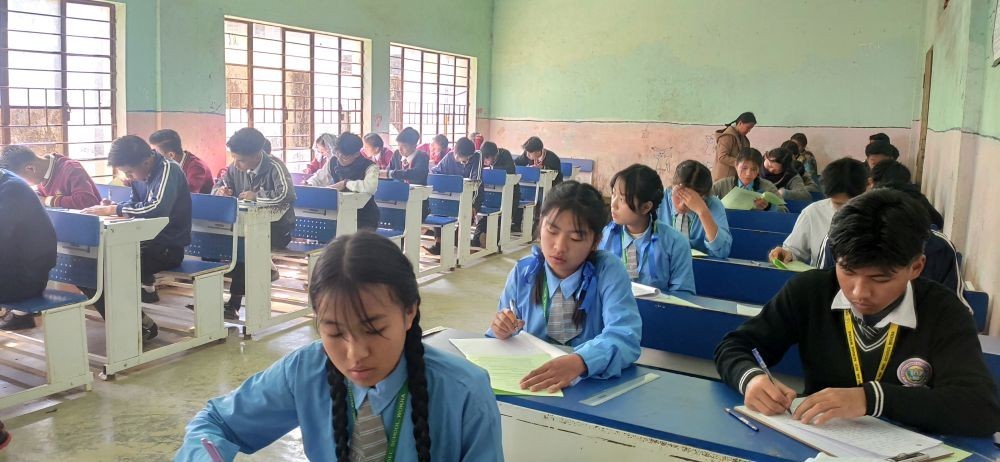
Morung Express News
Kohima | July 27
Nikashe Sema, Secretary to the Government of Nagaland, Fisheries Department today said that the fisheries practice in Nagaland is still primitive and therefore the fish farmers need to technically upgrade themselves with modern type of farming in order to produce sufficiently in the State.
Speaking as chief guest at the inaugural session of a two-day workshop on ‘Co-management of fisheries and aquaculture in Nagaland’ being held from July 27 to 28 at Hotel Japfü, the Secretary further urged the participants to acquire enough knowledge and disseminate it to other farmers.
The seminar is organized by the Department of Fisheries, Nagaland in collaboration with College of Fisheries CAU, Tripura.
“Nagas are yet to become fish farmers,” said Kevisa Kense, Director of Fisheries Department while delivering an overview of Fishery activities in Nagaland. The Department which has targeted a self sufficiency of fishes for the State by 2030 under the State vision plan is planning to identify various species of fishes which will be suitable for climatic conditions in the state and also develop proper catchment areas to promote indigenous fishes.
Citing the Doyang Reservoir (2258 hectare) which has benefitted surrounding villages, Kense mentioned that 350 to 400 families are solely dependent on the catchment of the reservoir. Thus, the efforts of the department has not only elevated the socio-economy of the area but also reduced anti social activities, viewed Kense.
The recent achievements of the Department has been the declaration of Chocolate Mahseer as the State Fish, conservation and promotion of aquatic species of stream fisheries and enhancement of fish production, construction of fresh water fish seed hatchery, cage culture at Doyang Reservoir, successful breeding and culture of giant fresh water prawn, successful rearing of ornamental fish.
Breeding of 17 numbers of exotic ornamental fish species have been successfully conducted at the aquarium unit and further trainings on prospects of aquaculture and fisheries in the grassroots level were conducted besides distribution of floating fish feed to progressive farmers.
Trainings were also given to fish traders on hygiene and sanitation in market places.
At present, the fish production in Nagaland is 8820 MT and fish seed production is 478 lakhs. There are 8 districts demonstrations of fish farms in Nagaland, one cold storage in Dimapur, one ice plant, two prawn hatchery, one awareness centre, five farming centres, and one retail fish marketing outlet.
R K Majumdar, Associate Professor & HoD, College of Fisheries, CAU, Lembucherra, Tripura in his address stated that farmers need to farm fishes according to market demand and that management is one major aspect which will help them to improve fish farming in Nagaland.
The technical session of the workshop included presentations on ‘Fisheries and technology adopted in respective districts of Nagaland’ by District Fishery Officers of Kohima, Phek, Mokokchung, Peren and Dimapur, ‘Activities under FAB-COE’ by Dr. RK Majumdar, ‘Potentials in diversification of Fisheries in NE India’ by Dr. Sagar C Mandal.
The second day of the workshop on July 28 will witness presentations on ‘Scope and avenues in developing/enhancing ornamental fish trade’ by Dr. Sagar C. Mandal, ‘Value added fish products in context of NE region’ by D. R K Majumdar, ‘Potentials in diversification of fisheries in NE India’ by Dr. Sager C. Mandal. The workshop will conclude with brainstorming among participants on emerged issues and finalization of priority areas and comprehensive action plans to improve the aquaculture activities in Nagaland through R & D.
Nagaland is a state with per capita fish consumption rate of 6.10 kg while the per capita production is just 4 kg. The state imports more than 3850 MT Fish every year to meet the demands of people. The total fish production is 8220 MT while the average productivity levels of fish from ponds, paddy cum fish culture and reservoir fisheries is 2100, 335, 500 and 158 kgs/ha/yr respectively, according to the Centre of Excellence in Fisheries and Aquaculture Biotechnology (FAB-COE).
The riverine eco system in Nagaland faces threats of degradation due to sand mining, dumping of sewage directly into the rivers, coal mining, dynamite fishing and poisoning in hill streams.
Nagaland also has prospective scope for developing ornamental fisheries, cold water fisheries and giant fresh water prawn farming. Aquaculture is one of the major sectors of food production in Nagaland where the value of fish and its byproducts have increased over the years. Some of the constraints and challenges in Nagaland are lack of organized market, lack of scientific knowledge among fish farmers, lack of aquaculture insurance at par with agriculture, limited financial power at district and field levels, non-availability of quality fish seed and feed, and lack of training infrastructure.
The future prospects in Nagaland, according to FAB COE, are diversification of aquaculture by introducing new candidate species, opportunities of fish farming in enclosures, reservoirs and slow moving rivers, locally grown fish which offers higher remunerations, development of fish seed production enterprise, fish marketing and control etc.


.jpg)
.jpg)
.jpg)
